Present continuous 1
Look at the picture and complete the sentences with the present continuous.
MY TIMETABLE
Els alumes de 4th han treballat subjects i timetable.
OBJECTIUS:
– Escriure sobre les subjects treballades a classe.
ACTIVITATS:
– Repasar la cançó “I’ve got Music on Monday”.
– Completar els seus timetables amb el vocabulari que s’ha après al tema.
– Seguint un model de frase del llibre del alumne, escriure frases des del Monday fins al Friday amb les subjects que treballen al llarg de la setmana.
– Comprobar que l’activitat està correcta fent una correcció oral amb tota la classe llegint, els mateixos, les frases que han escrit.
Vocabulari:
Maths
Language
English
Science
Art
Music
P.E.
4th A
|
DAY/TIME |
MONDAY |
TUESDAY |
WEDNESDAY |
THURSDAY |
FRIDAY |
|
9 – 10 |
English |
Maths |
Maths |
Language |
|
|
10 – 11 |
|
Language |
Language |
Maths |
|
|
11 – 11:30 |
break |
break |
break |
break |
break |
|
11:30 – 12:15 |
Language |
Language |
Art |
Maths |
Science |
|
12:15 – 13 |
Maths |
English |
Art |
P.E. |
Language |
|
13 – 15 |
lunch |
lunch |
lunch |
lunch |
lunch |
|
15 – 16 |
Science |
Science |
Science |
Science |
P.E. |
|
16 – 17 |
Music |
|
|
English |
Science |
1. I’ve got English, Language, Maths, Science and Music on Monday
but I haven’t got P.E.
2. I’ve got Maths, Language, English and Science on Tuesday
but I haven’t got Art.
3. I’ve got Maths, Language, Art and Science on Wednesday
but I haven’t got English.
4. I’ve got Language, Maths, P.E., Science and English on Thursday
but I haven’t got Music.
5. I’ve got Science, Language and P.E. on Friday
but I haven’t got Maths.
4th B
|
DAY/TIME |
MONDAY |
TUESDAY |
WEDNESDAY |
THURSDAY |
FRIDAY |
|
9 – 10 |
|
Maths |
|
Language |
English |
|
10 – 11 |
|
Language |
Language |
Maths |
P.E. |
|
11 – 11:30 |
break |
break |
break |
break |
break |
|
11:30 – 12:15 |
Language |
Language |
Art |
Maths |
Maths |
|
12:15 – 13 |
English |
Science |
Art |
|
Language |
|
13 – 15 |
lunch |
lunch |
lunch |
lunch |
lunch |
|
15 – 16 |
P.E. |
Maths |
Science |
English |
|
|
16 – 17 |
Science |
Science |
Science |
Music |
|
1. I’ve got Language, English, P.E. and Science on Monday
but I haven’t got Art.
2. I’ve got Maths, Language and Science on Tuesday
but I haven’t got P.E.
3. I’ve got Language, Art and Science on Wednesday
but I haven’t got Music.
4. I’ve got Language, Maths, English and Music on Thursday
but I haven’t got Science.
5. I’ve got English, P.E., Maths and Language on Friday
but I haven’t got Art.
SAINT GEORGE AND THE DRAGON 3r
WHAT’S … WEARING?
Els nens i nenes de 3r ens fan les descripcions de quina roba porten cadascun dels seus personatges.
What’s Ivan wearing?
He’s wearing a white shirt,
green jeans,
yellow socks and
red trainers.
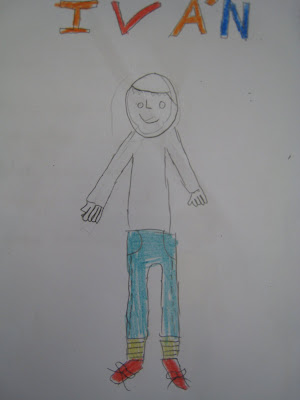 |
| De what’s … wearing? |
What’s Mª Angeles wearing?
She’s wearing a blue jumper,
a purple skirt,
pink socks and
orange shoes.
 |
| De what’s … wearing? |
What’s Toni wearing?
He’s wearing a yellow T-shirt,
blue jeans,
orange socks and
green trainers.
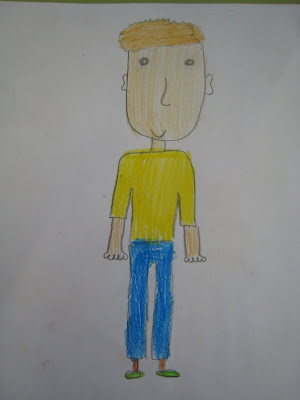 |
| De what’s … wearing? |
What’s Sarah wearing?
She’s wearing a pink T-shirt,
a blue skirt,
purple socks and
orange trainers.
 |
| De what’s … wearing? |
What’s Marc wearing?
He’s wearing a blue T-shirt,
red jeans,
white socks and
blue trainers.
 |
| De what’s … wearing? |
What’s Karen wearing?
She’s wearing a red cap,
a pink track suit,
pink socks and
grey trainers.
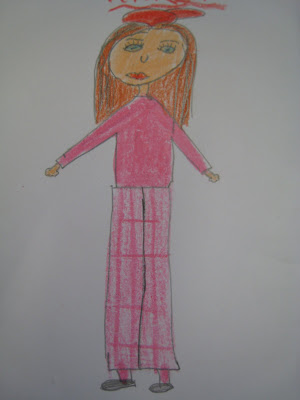 |
| De what’s … wearing? |
What’s Luis wearing?
He’s wering a blue T-shirt,
white trousers,
grey socks and
blue trainers.
 |
| De what’s … wearing? |
What’s Thalia wearing?
She’s wearing a pink shirt,
a red skirt,
purple socks and
orange shoes.
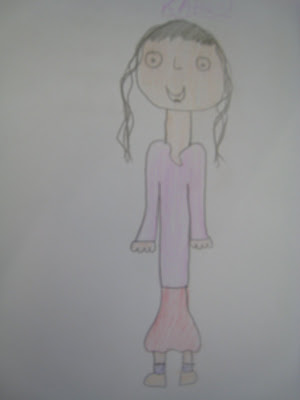 |
| De what’s … wearing? |
What’s Marc wearing?
He’s wearing a blue jumper,
green jeans,
red socks and
yellow trainers.
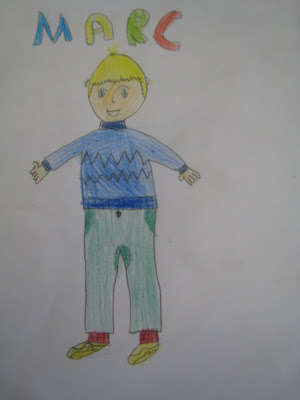 |
| De what’s … wearing? |
What’s Lisa wearing?
She’s wearing a pink jumper,
a red skirt, orange socks and
purple shoes.
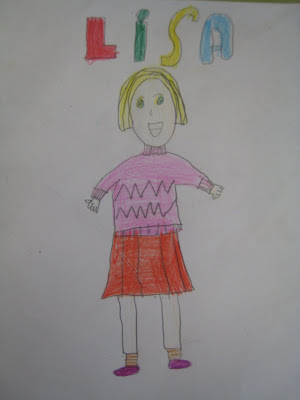 |
| De what’s … wearing? |
What’s Daniel wearing?
He’s wearing a purple shirt,
blue trousers,
orange socks and
black trainers.
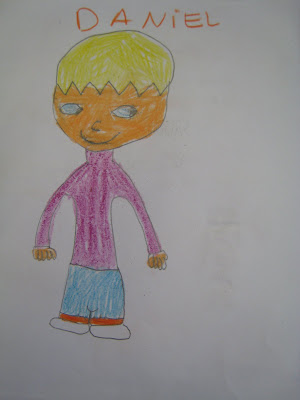 |
| De what’s … wearing? |
What’s Karen wearing?
She’s wearing a red jumper,
a pink skirt,
white socks and
yellow shoes.
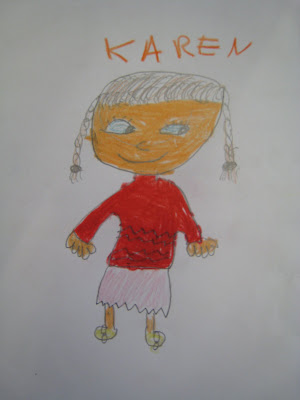 |
| De what’s … wearing? |
What’s Ruben wearing?
He’s wearing a red shirt,
blue jeans,
yellow socks and
orange trainers.
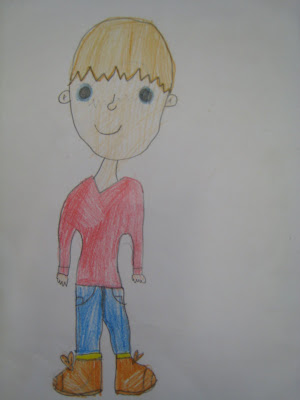 |
| De what’s … wearing? |
What’s Thalia wearing?
She’s wearing a purple shirt,
a blue skirt,
pink socks and
yellow shoes.
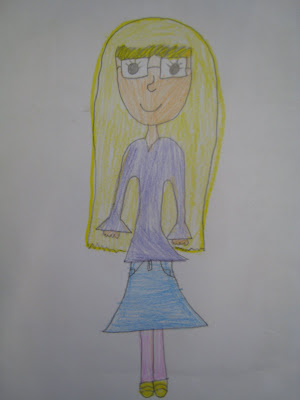 |
| De what’s … wearing? |
What’s Marc wearing?
He’s wearing a green T-shirt,
grey jeans,
yellow socks and
brown trainers.
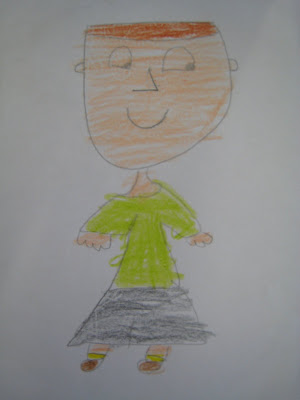 |
| De what’s … wearing? |
What’s Zamira wearing?
She’s wearing a pink jumper,
a blue T-shirt,
orange socks and
black trainers.
 |
| De what’s … wearing? |
What’s Philipe wearing?
He’s wearing orange socks,
red trainers,
blue jeans and
a yellow T-shirt.
 |
| De what’s … wearing? |
Waht’s Marta wearing?
She’s wearing red socks,
black trainers,
a blue track suit and
a black cap.
 |
| De what’s … wearing? |
What’ sLidia wearing?
She’s wearing a yellow T-shirt,
red jeans,
green socks and
pink trainers.
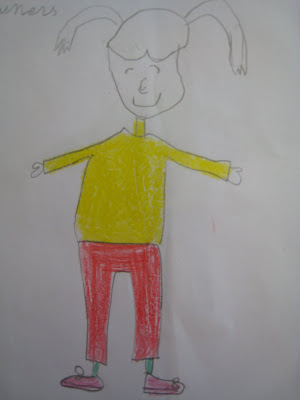 |
| De what’s … wearing? |
What’s Marcos wearing?
He’s wearing a green jumper,
blue jeans,
pink socks and
orange trainers.
 |
| De what’s … wearing? |
What’s Jordi wearing?
He’s wearing orange socks,
a red shirt,
blue jeans and
black trainers.
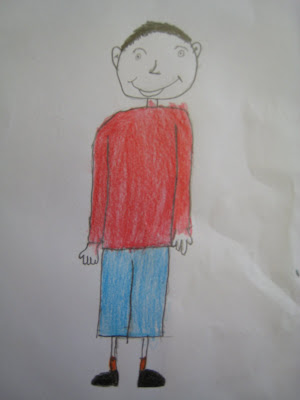 |
| De what’s … wearing? |
What’s Silvia wearing?
She’s wearing a blue T-shirt,
black socks,
orange shoes and
a red skirt.
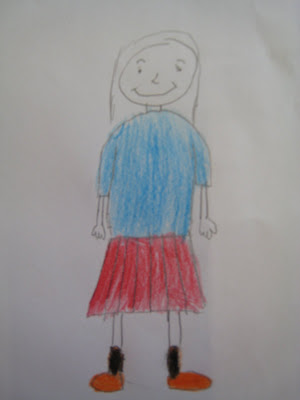 |
| De what’s … wearing? |
What’ s Carlos wearing?
He’s wearing a green jumper,
blue jeans,
yellow socks and
red trainers.
 |
| De what’s … wearing? |
What’s Nuria wearing?
She’s wearing a red T-shirt,
a red skirt,
purple socks and
black shoes.
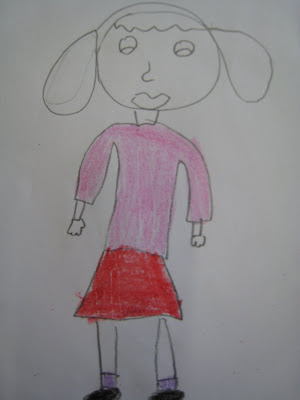 |
| De what’s … wearing? |
What’s Anna wearing?
She’s wearing red trousers,
a purple jumper,
blue socks and
pink shoes.
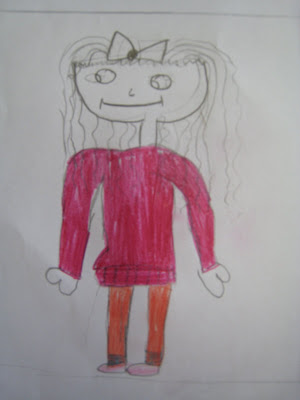 |
| De what’s … wearing? |
What’s Carlos wearing?
He’s wearing a blue jumper,
orange trousers,
red socks and
purple shoes.
 |
| De what’s … wearing? |
What’s Ferran wearing?
He’s wearing orange trainers,
blue jeans,
a purple shirt and
pink socks.
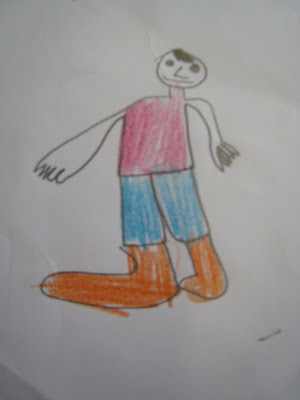 |
| De what's … wearing? |
APRIL FOOL’S DAY.
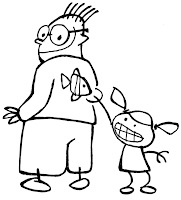 El día 1 de abril se celebra el April fool’s Day. Al parecer, pues hay diversas creencias sobre su origen, hasta el s. XVI se celebraba la llegada del año nuevo en esa fecha y no como actualmente el 1 de Enero con la introducción del calendario gregoriano.
El día 1 de abril se celebra el April fool’s Day. Al parecer, pues hay diversas creencias sobre su origen, hasta el s. XVI se celebraba la llegada del año nuevo en esa fecha y no como actualmente el 1 de Enero con la introducción del calendario gregoriano.
Dicen que fue en Francia donde surgió la tradición del April fool’s Day debido a que algunas personas no se enteraron del cambio de calendario y continuaban celebrando la nochevieja tal y como lo hacemos nosotros con cenas, fiestas y bailes, el día 1 de abril. Otros, aquellos que conocían la nueva tradición, se reían de los que celebraban nochevieja en abril, se dedicaban a molestarles y a gastarles bromas. Los llamaban “los tontos de abril” (April fools).
Actualmente en Francia celebran el Poisson d’Avril o April Fish que consiste en pegar a uno de tus amigos o a un desconocido un recorte con forma de pez en la espalda.
April fool’s Day también se celebra en muchos países de habla inglesa playing or pulling pranks. Cualquiera que sea la broma, si la inocente víctima cae en ella el bromista le grita: April fool!
Els nens i les nenes de 6è ens han fet unes “notícies” molt especials per un dia tan especial.
BubbleShare: Share photos – Easy Photo Sharing
MY MONSTER
Els nens i les nenes de 3r han començat a fer descripcions divertides.
This is Marc, my monster.
The monster has got one head, four noses, five ears, four eyes, nine mouths and eight necks.
The monster has got ten arms, ten hands and eleven fingers.
The monster has got two legs and ten feet.
My monster is happy.
 |
| De My monster |
This is Tommy, my mosnter.
The mosnter has got five heads, five noses, six ears, seven eyes, nine mouths and five necks.
The monster has got ten arms, ten hands and ten fingers.
The monster has got five legs and ten feet.
My monster is happy.
 |
| De My monster |
This is Manolo, my mosnter.
The mosnter has got three heads, four noses, five ears,, four eyes, six mouths and five necks.
The mosnter has got three arms, five hands and ten fingers.
The mosnter has got five legs and six feet.
My monster is happy.
 |
| De My monster |
This is Karen, my monster.
The mosnter has got six heads, twelve noses, three ears, seven eyes, eight mouths and six necks.
The monster has got two arms, four hands and eight fingers.
The monster has got two legs and five feet.
My mosnter is happy.
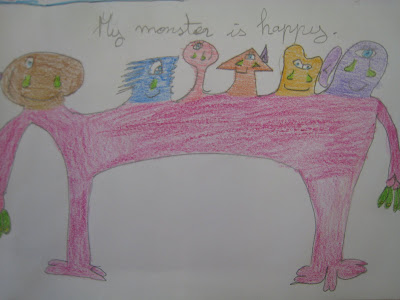 |
| De My monster |
This is Alex, my monster.
The monster has got two heads, four noses, three ears, five eyes, two mouths and three necks.
The monster has got five arms, eight hands and one finger.
The monster has got one leg and five feet.
My monster is happy.
 |
| De my monster 3rb |
This is Paul, my monster.
The monster has got five heads, six noses, eight ears, five eyes, ten mouths and seven necks.
The monster has got four arms, eight hands and ten fingers.
The monster has got five legs and eight feet.
My monster is scared.
 |
| De My monster |
This is Harry, my monster.
The monster has got three heads, one nose, four ears, two eyes, one mouth and five necks.
The monster has got two arms, five hands and six fingers.
The mosnter has got three legs and four feet.
My monster is happy.
 |
| De My monster |
This is Marc, my monster.
The monster has got five heads, eight noses, six ears, seven eyes, ten mouths and five necks.
The monster has got six arms, six hands and fifteen fingers.
The monster has got seven legs and ten feet.
The monster is happy.
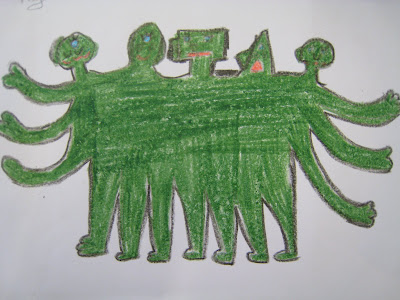 |
| De My monster |
This is Toni, my monster.
The monster has got three heads, six noses, five ears, seven eyes, nine mouths and three necks.
The monster has got five arms, six hands and eleven fingers.
The monster has got five legs and nine feet.
My monster is happy.
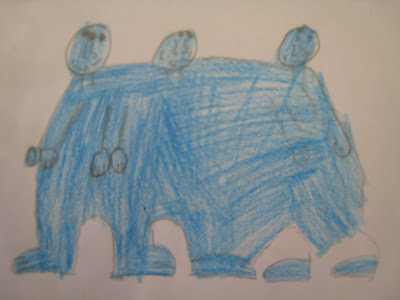 |
| De My monster |
This is Marc, my monster.
The monster has got two heads, two noses, five ears, four eyes, two mouths and two necks.
The monster has got seven arms, four hands and twenty fingers.
The monster has got four legs and four feet.
My monster is happy.
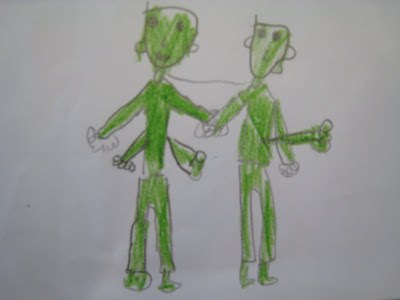 |
| De My monster |
This is Zag, my monster.
The monster has got one head, three ears, two mouths, threee eyes, four noses and one neck.
The monster has got five arms, six hands and one finger.
The monster has got two legs and three feet.
My monster is happy.
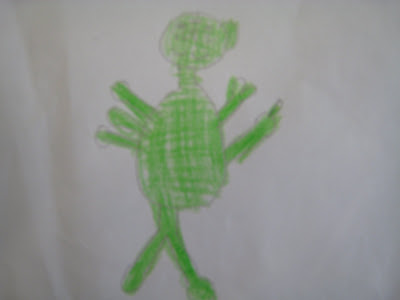 |
| De my monster 3rb |
This is Pol, my monster.
The monster has got three heads, four ears, five mouths, three eyes, eight noses and two necks.
The monster has got seven arms, eight hands and seven fingers.
The monster has got eight feet.
The monster is sad
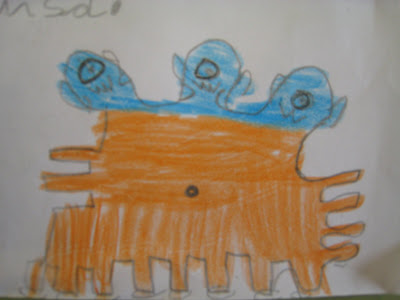 |
| De my monster 3rb |
This is Pepin, my monster.
The monster has got three heads, four ears, three mouths, five eyes, four noses and three necks.
The monster has got five arms, four hands and ten fingers.
The monster has got four legs and five feet.
The monster is happy.
 |
| De my monster 3rb |
This is Sue , my monster.
The monster has got two heads, three ears, four mouths, three eyes, six noses and two necks.
The monster has got six arms, seven hands and four fingers.
The monster has got five legs and six feet.
The monster is sad.
 |
| De my monster 3rb |
This is Sue, my monster.
The monster has got three heads, five mouths, six eyes, two noses and two necks.
The monster has got seven arms, four hands and eight fingers.
The monster has got six legs and six feet.
The monster is sad.
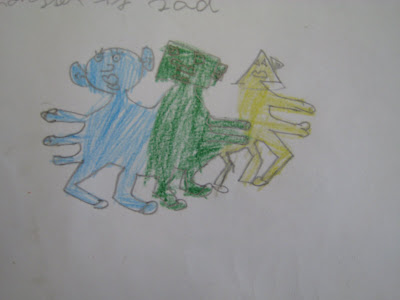 |
| De my monster 3rb |
This is Terrori, my monster.
The monster has got five heads, six ears, one mouth, two eyes, four noses and five necks.
The monster has got three arms, three hands and one finger.
The monster has got one leg and two feet.
The monster is scared.
 |
| De my monster 3rb |
This is Saima, my monster.
The monster has got four heads, two ears, five mouths, three eyes, one nose and four necks.
The monster has got four arms, three hands and two fingers.
The monster has got two and four feet.
The monster is happy.
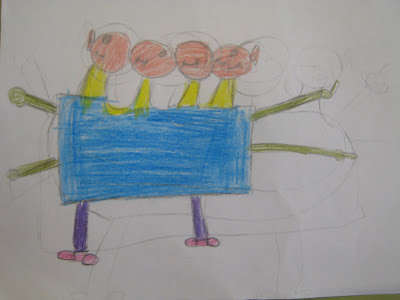 |
| De my monster 3rb |
This is Susie, my monster.
The monster has got three heads, one ear, six mouths, eight eyes, fou noses and two necks.
The monster has got five arms, six hands and two fingers.
The monster has got nine legs and one foot.
The monster is happy.
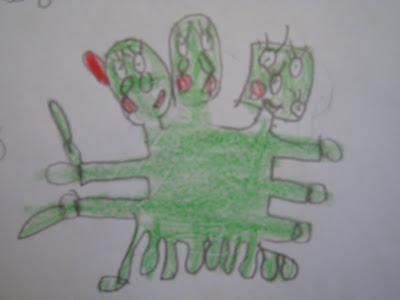 |
| De my monster 3rb |
This is Lola, my monster.
The monster has got three heads, five ears, three mouths, four eyes, two noses and three necks.
The monster has got four arms, six hands and nine fingers.
The monster has got four legs and ten feet.
The monster is happy.
 |
| De my monster 3rb |
This is Maria, my monster.
The monster has got three heads, seven eyes, four mouth, five ears, seven noses and four necks.
The monster has got eight arms, nine hands and three fingers.
The monster has got six legs and seven feet.
The monster is happy.
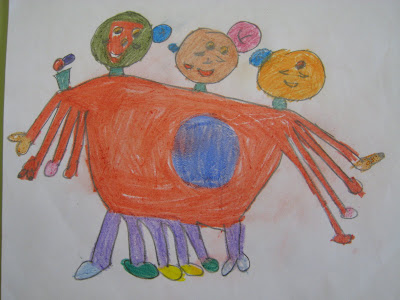 |
| De my monster 3rb |
This is Frank, my monster.
The monster has got three eyes, four ears, two heads, fives noses, two mouths.
The monster has got four arms and five fingers.
The monster has got seven feet.
 |
| De my monster 3rb |
This is Marc, my monster.
The monster has got one head, four ears, three eyes, two noses, two mouths and two necks.
The monster has got four arms, four hands and six fingers.
The monster has got three legs and fourfeet.
The monster is happy.
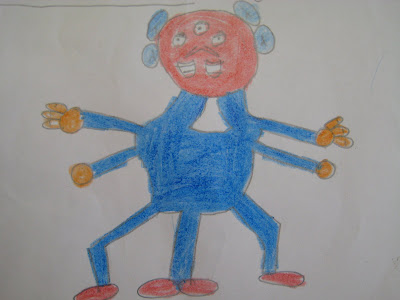 |
| De my monster 3rb |
This is Rot, my monster.
The monster has got one head, six ears, one mouth, four eyes, one nose and one neck.
The monster has got ten arms, ten hands and fifty fingers.
The monster has got one leg and two feet.
The monster is happy.
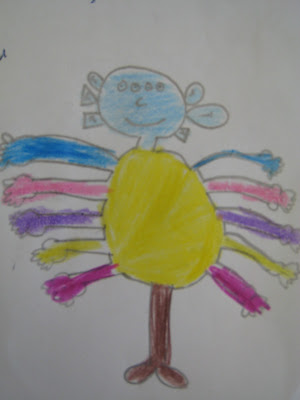 |
| De my monster 3rb |
This is Pepito, my monster.
The monster has got two heads, one ear, five mouths, two eyes, six noses and two necks.
The monster has got five arms, four hands and six fingers.
The monster has got four legs and five feet.
The monster is happy.
 |
| De my monster 3rb |
POEMS
Els alumnes de 5è de Primària han realitzat aquests poemes o “chants”.
OBJECTIUS
1. Llegir petits poemes o “chants”.
2. Crear el seu propi chant.
3. Memoritzar un chant.
ACTIVITATS D’ENSENYAMENT-APRENENTATGE
– Lectura , preparació i recitació d’un chant.
– Creació de nous “chants” a partir d’un model.
– Audició atenta.
– Demostració d’una actitud respetuosa i oberta cap a l’expressió d’altres companys.
In an old, old world
there is an old, old park,
and in the old, old park
there is an old, old shop,
and in the old, old shop
there is …MY FRIEND.
In an old, old world
there is an old, old city
and in the old, old city,
there is an old, old school,
and in the old, old school
there is … A TEACHER.
In a small, small school
there is a small, small classroom,
and in the small, small classroom
there is a small, small boy,
and in the small, small boy
there is … A BOOK.
In a nice, nice town
there is a nice, nice place,
and in the nice, nice place
there is a nice, nice park,
and in the nice, nice park
there is … A GIRL.
In a big, big sea
there is a big, big shark,
and in the big, big shark
there is a big, big fish,
and in the big, big fish
there is … A LITTLE FISH.
In a small, small house
there is a small, small bedroom,
and in the small, small bedroom
there is a small, small bed,
and in the small, small bed
there is … A MOUSE.
In a big, big town
there is a big, big zoo,
and in the big, big zoo
there is … A LION.
In a little, little circus
there is a little, little magician,
and in the little, little magician
there is a little, little hat,
and in the little, little hat
there is … A CAT.
In an old, old town
there is an old, old castle,
and in the old, old castle
there is … A GHOST.
In a beautiful, beautiful school
there is a beautiful, beautiful chair,
and in the beautiful, beautiful chair
there is a beautiful, beautiful notebook,
and in the beautiful, beautiful notebook
there is a beutiful, beautiful pencil,
and in the beautiful, beautiful pencil
there is a beautiful, beautiful rubber,
and in the beautiful, beautiful rubber
there is … A CLASSROOM.
In the big, big planet
there is a big, big comet,
and in the big, big comet
there is a big, big house,
and in the big, big house
there is … A MOUSE.
In an old, old wardrobe
there is an old, old box,
and in the old, old box
there is an old, old pencil case,
and in the old, old pencil case
there is … A PENCIL.
In the beautiful, beautiful sky
there is a beautiful, beautiful animal,
and in the bautiful, beautiful animal
there is a beautiful, beautiful day,
and in the bautiful, beautiful day
there is … A BUTTERFLY.
In a big, big home
there is a big, big kitchen
and in the big, big kitchen
there is a big, big table,
and in the big, big table
there is a big, big flower,
and in the big, big flower
there is … A SPIDER.
In a nice, nice house
there is a nice, nice room,
and in the nice, nice room
there is a nice, nice pencil case,
and in the nice, nice pencil case
there is … A PENCIL.
In a small, small continent
there is a small, small country,
and in the small, small country
there is a small, small sea,
and in the small, small sea
there is … A DOLPHIN.
In a big, big park
there is a big, big tree,
and in the big, big tree
there is a big, big nest,
and in the big, big nest
there is a big, big egg,
and in the big, big egg
there is … AN BIRD.
In the blue, blue sky
there is a blue, blue plane,
and in the blue, blue plane
there is … A PASSAGER.
In an old, old field
there is an old, old house,
and in the old, old house
there is an old, old living room,
and in the old, old living room
there is an old television,
and in the old, old television
there is … A BLUE FLOWER.
In a big, big country
there is a big, big village,
and in the big, big village
there is a big, big street,
and in the big, big street
there is a big, big school,
and in the big, big school
there is … A BOY.
MY STORY
“A BALLOON RIDE”
Aquestes activitats s’han realitzat amb els nens i nenes de 4t de primària.
OBJECTIUS
1. Fer i escriure accions relacionades amb el conte treballat a classe “A balloon ride”.
2. Crear un conte propi seguint un model donat.
ACTIVITATS D’ENSENYAMENT-APRENENTATGE
– Audició i seguiment de la història “A Balloon ride”.
– Discriminació de frases veritables/falses sobre la història.
– Finalització d’un text substituint dibuixos per la paraula corresponent.
– Compleció il·lustració d’una història semblant a la treballada al llarg de la unitat.